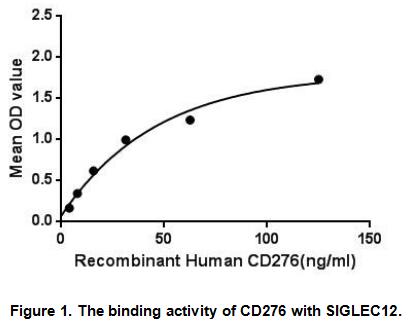Active Cluster Of Differentiation 276 (CD276)
B7-H3; B7H3; CD276 Molecule; B7 homolog 3; Costimulatory molecule
- Product No.UAPA781Hu01
- Organism SpeciesHomo sapiens (Human) Same name, Different species.
- Buffer Formulation20mM Tris, 150mM NaCl, pH8.0, containing 1mM EDTA, 1mM DTT, 0.01% SKL, 5% Trehalose and Proclin300.
- TraitsFreeze-dried powder
- Purity> 97%
- Isoelectric Point5.9
- ApplicationsCell culture; Activity Assays.
- Download Instruction Manual
- UOM 10µg50µg 200µg 1mg 5mg
-
FOB
US$ 173
For more details, please contact local distributors!US$ 432
For more details, please contact local distributors! US$ 864
For more details, please contact local distributors! US$ 2592
For more details, please contact local distributors! US$ 6480
For more details, please contact local distributors!
ACTIVITY TEST of the Active Cluster Of Differentiation 276 (CD276)

Cluster Of Differentiation 276 (CD276) also known as B7-H3 in human, is a member of the B7/CD28 superfamily of costimulatory molecules serving as an accessory modulator of T-cell response. B7 proteins are immunoglobulin (Ig) superfamily members with extracellular Ig-V-like and Ig-C-like domains and short cytoplasmic domains. Among the family members, they share about 20-40% amino acid (aa) sequence identity. CD276 may play a protective role in tumor cells by inhibiting natural-killer mediated cell lysis as well as a role of marker for detection of neuroblastoma cells. It has also been found to enhance the induction of primary cytotoxic T lymphocytes and stimulate IFN-gamma production. Besides, Sialic acid-binding Ig-like lectin 12 (SIGLEC12) has been identified as an interactor of CD276, thus a binding ELISA assay was conducted to detect the interaction of recombinant human CD276 and recombinant human SIGLEC12. Briefly, CD276 were diluted serially in PBS, with 0.01% BSA (pH 7.4). Duplicate samples of 100uL were then transferred to SIGLEC12-coated microtiter wells and incubated for 2h at 37℃. Wells were washed with PBST and incubated for 1h with anti-CD276 pAb, then aspirated and washed 3 times. After incubation with HRP labelled secondary antibody, wells were aspirated and washed 3 times. With the addition of substrate solution, wells were incubated 15-25 minutes at 37℃. Finally, add 50µL stop solution to the wells and read at 450nm immediately. The binding activity of CD276 and SIGLEC12 was shown in Figure 1, and this effect was in a dose dependent manner.
USAGE of the Active Cluster Of Differentiation 276 (CD276)
Reconstitute in 20mM Tris, 150mM NaCl (pH8.0) to a concentration of 0.1-1.0 mg/mL. Do not vortex.
STORAGE of the Active Cluster Of Differentiation 276 (CD276)
Avoid repeated freeze/thaw cycles. Store at 2-8°C for one month. Aliquot and store at -80°C for 12 months.
STABILITY of the Active Cluster Of Differentiation 276 (CD276)
The thermal stability is described by the loss rate. The loss rate was determined by accelerated thermal degradation test, that is, incubate the protein at 37°C for 48h, and no obvious degradation and precipitation were observed. The loss rate is less than 5% within the expiration date under appropriate storage condition.
INCREMENT SERVICES
BCA Protein Quantification Kit
Molecular Mass Marker for Protein
Monoclonal Antibody Customized Service
Polyclonal Antibody Customized Service
Protein Activity Test Experiment Service
Electrophoretic Mobility Shift Assay (EMSA) Experiment Service
Buffer
Lentivirus Packaging Experiment Service
Adenovirus Packaging Experiment Service
Real Time PCR Experimental Service
Spike RBD Protein (S-RBD)
Protein G
Protein A
Related products
| Catalog No. | Organism species: Homo sapiens (Human) | Applications (RESEARCH USE ONLY!) |
| UAPA781Hu01 | Active Cluster Of Differentiation 276 (CD276) | Cell culture; Activity Assays. |
| URPA781Hu01 | Recombinant Cluster Of Differentiation 276 (CD276) | Positive Control; Immunogen; SDS-PAGE; WB. |
| UPAA781Hu01 | Polyclonal Antibody to Cluster Of Differentiation 276 (CD276) | WB; IHC; FCM |
| UFAA781Hu01 | Anti-Cluster Of Differentiation 276 (CD276) Polyclonal Antibody | FCM |
| UMAA781Hu22 | Monoclonal Antibody to Cluster Of Differentiation 276 (CD276) | WB |
| UMAA781Hu21 | Monoclonal Antibody to Cluster Of Differentiation 276 (CD276) | WB; IHC; ICC; IP. |
| USEA781Hu | ELISA Kit for Cluster Of Differentiation 276 (CD276) | Enzyme-linked immunosorbent assay for Antigen Detection. |
| ULMA781Hu | Multiplex Assay Kit for Cluster Of Differentiation 276 (CD276) ,etc. by FLIA (Flow Luminescence Immunoassay) | FLIA Kit for Antigen Detection. |



